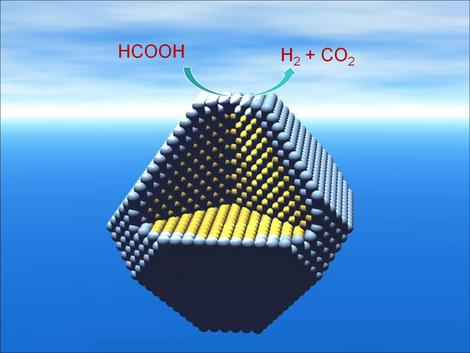Home > Press > Putting a fuel cell 'in your pocket'
 |
| Image: the core-shell particle (palladium atoms on a silver nanoparticle). |
Abstract:
Technology using catalysts which make hydrogen from formic acid could eventually replace lithium batteries and power a host of mobile devices.
Edman Tsang of Oxford University's Department of Chemistry and colleagues are developing new catalysts which can produce hydrogen at room temperature without the need for solvents or additives.
Putting a fuel cell 'in your pocket'
Oxford, UK | Posted on April 15th, 2011Their initial results, reported in a recent paper in Nature Nanotechnology, are promising and suggest that a hydrogen fuel cell in your pocket might not be that far away.
The new approach involves placing a single atomic layer of palladium atoms onto silver nanoparticles. ‘The structural and electronic effects from the underlying silver greatly enhance the catalytic properties of palladium, giving impressive activity for the conversion of formic acid to hydrogen and carbon dioxide at room temperature,' Edman told us.
He explains that the storage and handling of organic liquids, such as formic acid, is much easier and safer than storing hydrogen. The catalysts would enable the production of hydrogen from liquid fuel stored in a disposable or recycled cartridge, creating miniature fuel cells to power everything from mobile phones to laptops.
Another advantage of the new technology is that the gas stream generated from the reaction is mainly composed of hydrogen and carbon dioxide but virtually free from catalyst-poisoning carbon monoxide; removing the need for clean-up processes and extending the life of the fuel cells.
The chemists have worked closely with George Smith, Paul Bagot and co-workers at Oxford University's Department of Materials to characterise the catalysts using atom probe tomography. The underlying technology is the subject of a recent Isis Innovation patent application.
‘There are lots of hurdles before you can get a real device, but we are looking at the possibility of using this new technology to replace lithium battery technology with an alternative which has a longer lifespan and has less impact on the environment,' explains Edman.
Professor Edman Tsang is based at Oxford University's Department of Chemistry.
####
About University of Oxford
Oxford is the oldest university in the English-speaking world, and a leader in learning, teaching and research.
For more information, please click here
Contacts:
telephone:44 01865 280528
fax:44 01865 280535
email:
Copyright © University of Oxford
If you have a comment, please Contact us.Issuers of news releases, not 7th Wave, Inc. or Nanotechnology Now, are solely responsible for the accuracy of the content.
| Related News Press |
News and information
![]() Researchers develop molecular qubits that communicate at telecom frequencies October 3rd, 2025
Researchers develop molecular qubits that communicate at telecom frequencies October 3rd, 2025
![]() Next-generation quantum communication October 3rd, 2025
Next-generation quantum communication October 3rd, 2025
![]() "Nanoreactor" cage uses visible light for catalytic and ultra-selective cross-cycloadditions October 3rd, 2025
"Nanoreactor" cage uses visible light for catalytic and ultra-selective cross-cycloadditions October 3rd, 2025
![]() Researchers tackle the memory bottleneck stalling quantum computing October 3rd, 2025
Researchers tackle the memory bottleneck stalling quantum computing October 3rd, 2025
Chemistry
![]() "Nanoreactor" cage uses visible light for catalytic and ultra-selective cross-cycloadditions October 3rd, 2025
"Nanoreactor" cage uses visible light for catalytic and ultra-selective cross-cycloadditions October 3rd, 2025
![]() Cambridge chemists discover simple way to build bigger molecules – one carbon at a time June 6th, 2025
Cambridge chemists discover simple way to build bigger molecules – one carbon at a time June 6th, 2025
Discoveries
![]() Researchers develop molecular qubits that communicate at telecom frequencies October 3rd, 2025
Researchers develop molecular qubits that communicate at telecom frequencies October 3rd, 2025
![]() Next-generation quantum communication October 3rd, 2025
Next-generation quantum communication October 3rd, 2025
![]() "Nanoreactor" cage uses visible light for catalytic and ultra-selective cross-cycloadditions October 3rd, 2025
"Nanoreactor" cage uses visible light for catalytic and ultra-selective cross-cycloadditions October 3rd, 2025
Announcements
![]() Rice membrane extracts lithium from brines with greater speed, less waste October 3rd, 2025
Rice membrane extracts lithium from brines with greater speed, less waste October 3rd, 2025
![]() Researchers develop molecular qubits that communicate at telecom frequencies October 3rd, 2025
Researchers develop molecular qubits that communicate at telecom frequencies October 3rd, 2025
![]() Next-generation quantum communication October 3rd, 2025
Next-generation quantum communication October 3rd, 2025
![]() "Nanoreactor" cage uses visible light for catalytic and ultra-selective cross-cycloadditions October 3rd, 2025
"Nanoreactor" cage uses visible light for catalytic and ultra-selective cross-cycloadditions October 3rd, 2025
Energy
![]() Sensors innovations for smart lithium-based batteries: advancements, opportunities, and potential challenges August 8th, 2025
Sensors innovations for smart lithium-based batteries: advancements, opportunities, and potential challenges August 8th, 2025
![]() Simple algorithm paired with standard imaging tool could predict failure in lithium metal batteries August 8th, 2025
Simple algorithm paired with standard imaging tool could predict failure in lithium metal batteries August 8th, 2025
Fuel Cells
![]() Deciphering local microstrain-induced optimization of asymmetric Fe single atomic sites for efficient oxygen reduction August 8th, 2025
Deciphering local microstrain-induced optimization of asymmetric Fe single atomic sites for efficient oxygen reduction August 8th, 2025
![]() Current and Future Developments in Nanomaterials and Carbon Nanotubes: Applications of Nanomaterials in Energy Storage and Electronics October 28th, 2022
Current and Future Developments in Nanomaterials and Carbon Nanotubes: Applications of Nanomaterials in Energy Storage and Electronics October 28th, 2022
|
|
||
|
|
||
| The latest news from around the world, FREE | ||
|
|
||
|
|
||
| Premium Products | ||
|
|
||
|
Only the news you want to read!
Learn More |
||
|
|
||
|
Full-service, expert consulting
Learn More |
||
|
|
||








